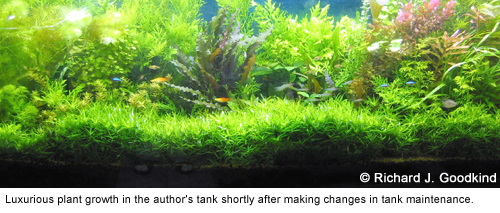
Some ten years ago, I embarked on what I thought would be a great adventure in the tropical fish hobby. I invested in state-of-the-art equipment, a 135-gallon [511 l] Oceanic tank complete with under-gravel heating cables under a laterite substrate, metal halide lighting, CO2 infusion and a wet/dry filtration system. For approximately the first two years the tank flourished. However, over the next few years I noticed a slow deterioration in the vitality of my plants and was completely unable to grow most Cryptocoryne and many green and red stem plants.
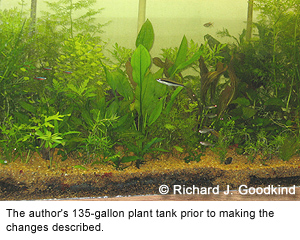
Over a six-year period I experienced great frustration trying to recapture my earlier success. It seemed that whatever first-aid measures I instituted —additional VHO lighting, substrate enhancement, etc.—the tank never lived up to my expectations. After purchasing a copy of Takashi Amano's book, Nature Aquarium World 3, I realized how less-than-luxurious my plant tank really appeared. Amano's photos inspired me to make additional changes to my aquarium setup.
After a few false starts, my local fish store (LFS) suggested that my lack
of success was probably due to the municipal water supply. My city has extremely
hard water and a pH of 8. They recommended adding pH Down
when making
water changes to lower the pH. My LFS also suggested I replace my 43°Kelvin
halides with three new 55°K metal halides, add two additional VHO fluorescent
lights and remove my surface skimmer to maintain a greater CO2 concentration
in my water column.
I also added an RO [reverse osmosis] filter. Although these steps made slight improvements to my tank's appearance, I was still not able to achieve the results that appeared in Amano's photographs.
Then by happenstance I was introduced to another hobbyist who lived two miles from my home. He invited me to visit his aquariums. Although he used the same city water supply, it was immediately apparent that his tanks had the lush growth that I was unable to achieve. The contrast between his tanks and mine was astonishing!
Since we were both retired, I asked if he would be willing to impart some of his knowledge to help me obtain a flourishing plant tank. He agreed, and estimated that with my keen interest in the hobby, he could help me achieve my goal in approximately three to four weeks. He was right and I would like to share with you the straightforward steps that have enabled me to create a lush 135-gallon plant tank.
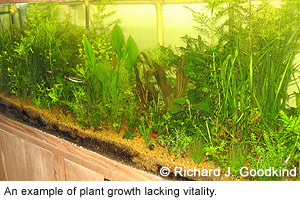
Initially, it was important to understand that the water chemistry in my existing tank was a major inhibitor to satisfactory plant growth. To rectify this situation I purchased five LaMotte test kits to evaluate my water quality: phosphate, nitrate, iron, hardness and CO2. These tests revealed that the tank's phosphate levels were 100 ppm and the iron concentration was 0.3 ppm. Both conditions contributed to Cryptocoryne rot and algae growth on the leaves of many of my plants. My new acquaintance informed me that my 25% water change every two to three weeks was inadequate. Moreover, lowering my pH with a product that introduced phosphates into my tank via its phosphoric acid formulation was counter-productive, further enhancing my algae build-up. Finally, my Bare Bones RO unit was not efficient enough to remove the salts from my water softener (99% sodium chloride), a situation that contributed to my unfavorable water quality.
To improve the vitality and water quality of my tank I took the following steps: First, I installed a new three-canister RO unit. This produced RO water with pH of 5.5 and no appreciable water hardness. Second, I hired a plumber to install a low cost bypass that circumvented the existing water softener. I mixed one-third city water with two-thirds RO water. This enabled me to obtain water for my tanks with a pH between 7.0 and 7.3 and a KH of 4 dH with no measurable phosphates and nitrates. Third, I instituted a 50% water change every week. These changes prevented the tank from accumulating high concentrations of fertilizer and helped to reduce the excessive phosphates. My life-saving friend informed me that I could have used city water and gotten the same results without purchasing the 50-gallon-per-day RO unit, but I felt more comfortable blending the two water supplies.
Fourth, in addition to these simple but necessary modifications, I added Eco-Complete Aquarium Substrate (Carib Sea) to my somewhat depleted gravel substrate. Fifth, I installed two submersible powerheads connected to Aqua Clear Quick filters to provide additional water current and filtration, and I purchased polyester filter material at a local fabric store to replace the 1-micron factory filters I had been using. The increased turbulence provided by the powerheads gave more nutrients in the water column a chance to contact the leaves of the plants. I now clean these quick disconnect filters religiously every third day. Finally I changed my method of administering CO2 by adding it directly to a newly fabricated L-shaped PVC fitting, which dispersed gas throughout the entire length of the tank. The power source for the system is a Lifegard Quiet One.
After the first 50% water change, I added plants to the existing ones that already inhabited the tank: Vallisneria spiralis var. tortifolia, Cryptocoryne beckettii, C. affinis, C. wendtii, C. walkeri, Java fern, Riccia fluitans, Bacopa monnieri, red and green Cabomba, Hygrophila corymbosa, Heteranthera zosterifolia, Ammannia senegalensis and Rotala macrandra.
I administered a dose of PMDD [Ed. Note: poor
man's dosing drops
are a homemade fertilizer recipe available on the
Internet] of 8 –10 ml each day while trying to achieve a target level of
0.1 ppm iron, 1 ppm phosphate, 10 ppm nitrate, 20 ppm potassium and 7 –8
ppm CO2. Using the Lamotte test kits, I started to monitor the water
column on a regular basis.

In just a few short weeks, plant growth became luxurious. In fact the tank itself was completely rejuvenated. It was difficult to believe that such a complete metamorphosis could occur in such a short time. The initial algae problem was reduced noticeably, and a dozen or more Otocinclus vittatus were added to the tank to keep the algae problem within acceptable limits.
My fellow hobbyist gave me the impetus to understand the value of water chemistry, the role that the substrate plays in plant growth, and the role the water column plays in providing the necessary nutrients to underwater plants. In addition, he stressed how important it is to maintain tank cleanliness and good water.
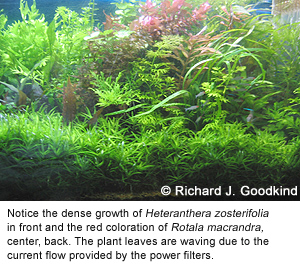
I was fortunate that I became acquainted with an aquarist who had the knowledge and the time to spend teaching the nuances that he had learned throughout his years in the hobby. Hobbyists who are willing to share their experiences can be invaluable resources in helping another hobbyist to establish a successful plant tank.
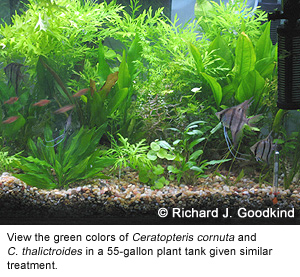
My benefactor gives much of the credit for his information on plant tank up-keep to the Krib web site, The Aquatic Gardener, Journal of the Aquatic Gardeners Association and the Sears-Conlin paper. [Ed. Note: This paper, the source of the PMDD system, can be found at www.thekrib.com/Plants.] The internet can also provide additional invaluable information to the hobbyist who is willing to devote the time to searching the net to achieve a luxurious plant tank.
To achieve a predictable result, CO2 infusion, sufficient lighting and a fortified substrate are necessary components. However, in my experience they will not produce the optimum plant tank. Understanding water chemistry, testing water quality with accurate kits, providing regular tank maintenance, providing water column flow and weekly water changes are equally important factors. Achieving a vibrant plant tank has greatly renewed my interest and enthusiasm for this wonderful world of aquatics.

Nitrogen Processes and Cycling in Planted Aquariumsby Tom Barr; The Aquatic Gardener Vol. 17 No. 4 2004
***A special debt of gratitude is owed to Veryl Ofstad for sharing his accumulated knowledge of proper plant tank maintenance and web site sources. Without his persistent prodding and vigilant observations, my goal of achieving a lush plant tank would not have been possible in such a short time.